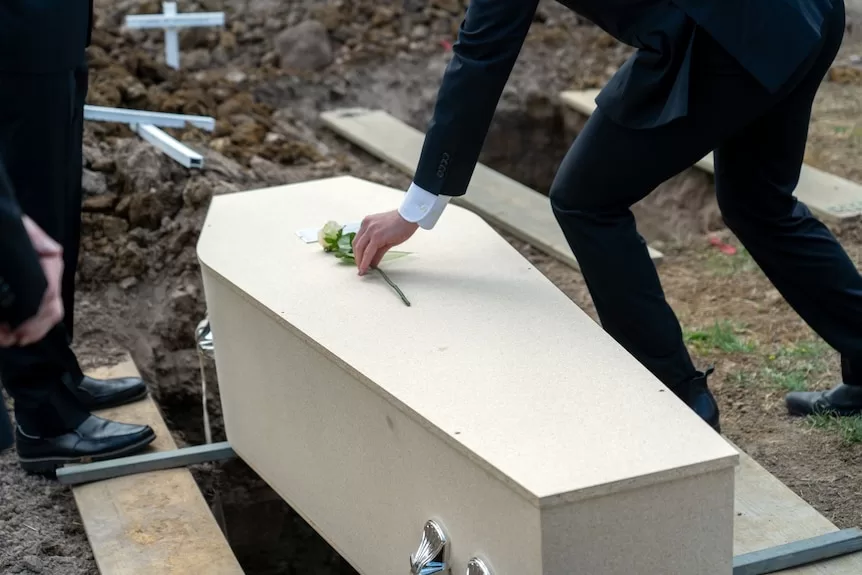The burial is over in a matter of minutes.
Four funeral staff stand around the grave — it is the minimum number of people required.
Any fewer and the coffin couldn’t be gently lowered into the ground.
They solemnly say the Lord’s Prayer, but nobody knows if the deceased was religious, let alone Christian.
There are no family or friends present at most of these burials, instead State Trustees has taken charge of the occasion.
When someone dies in Victoria and no next of kin can be found — or no-one volunteers to pay for a burial — State Trustees becomes responsible.
Since 2007, Old Ballan Cemetery is one of several locations in Victoria that State Trustees has been using to inter the people who have nowhere else to go.
Located on windswept plains a little over an hour’s drive west of Melbourne, the cemetery is almost indistinguishable from the surrounding paddocks.
A smattering of crumbling, slanting headstones is the only sign of the hundreds buried at Old Ballan in the early years of European settlement.
By 1875, what’s known as the New Cemetery had opened much closer to Ballan and the old cemetery lay idle until it was reopened for State Trustee burials.
State Trustees needed to find an affordable cemetery with the requisite space because cremation is not an option, Ballan Cemeteries Trust secretary Merilyn Meadows says, in case a relative appears at a later time and wants the body exhumed and moved to another cemetery.
While exhuming remains is rare, people often contact Ms Meadows searching for someone buried at Old Ballan.
“It’s surprising how often people are estranged from others,” she says.
“All of a sudden, they’ve realised that this person that was in their family is no longer with them … they make enquiries and find out they’re at Ballan and the next thing we get a phone call, it’s very regular.”
A paddock of white crosses
A simple white cross made of plastic agricultural fence post marks each grave.
More affordable and longer lasting than timber crosses, Allan Barr says he devised this method during the 10 years he oversaw the upkeep and management of the cemetery.
The names of the dead are written on with permanent marker, but after several years they disappear, scorched by the light and the weather.
As a volunteer-run cemetery, respecting the dead and balancing a small budget is a constant worry.
But each of the pauper burials, as Mr Barr calls them, is undertaken with respect and dignity, he says.
“People live on this Earth for a certain time, and the least you can do for them is give them a bit of a send-off,” he says.
“Because, you know, if the people who knew them and loved them or supposedly loved them, didn’t do a lot for them, we felt we needed to do something. And that’s why we did it and still do it.”
Walking through the rows of crosses, mostly men’s names appear — far more men than women are buried by State Trustees.
Occasionally there is one with a headstone.
“Strong in his beliefs, as he was in his actions” reads one headstone; another celebrates an “indomitable spirit”, while another says it was funded by some “atheist Twitter mates”.
Ms Meadows says sometimes families discover a relative is buried in Ballan and organise a stone or plaque to replace the simple cross.
‘Giving them somewhere to be’
State Trustees arranges approximately 200 burials or cremations each year.
A representative says they only cremate when they know this aligns with the wishes of the deceased person.
Ms Meadows believes on average more than 100 people a year are buried in the State Trustee section of the cemetery.
And the ever-expanding mass of white crosses is presenting a novel problem for the Ballan Cemeteries Trust.
According to the local historical society, it is believed several hundred people were buried in the Old Cemetery prior to 1875, but the records were lost and the location of most of these graves is unknown.
Fearing the new graves might uncover the old, Ms Meadows has secured a small grant for ground-penetrating radar work to identify the location of the original graves.
She hopes to secure other grants to digitise the cemetery records, buy a new mower and extend the gravel driveways within the cemetery, such is the tight budget of the cemetery’s trust.
Despite her zeal, Ms Meadows hopes her tenure is temporary and that she can find a new volunteer to replace herself.
She’s older than a lot of the people buried in the cemetery, she says.
“You can say it’s thankless but it’s not,” says Mr Barr, who is approaching his 80th birthday and retired from the role due to ill health.
Caring for the graves of the dead nobody claimed sharpens your perspective on what is important in life, he says, recalling the case of a family who reunited too late.
“A chap was buried, there was no-one there, next thing I get a phone call from a lady from Perth who thought it might have been her son,” he says.
The mother and son hadn’t spoken in 40 years after arguing, Mr Barr says.
Eventually the mother and her other sons travelled to Ballan and Mr Barr showed them to the grave and they replaced the simple cross with a headstone.
“There were several stories like that, and it was good to be able to help in the end,” Mr Barr says.
For whatever reason, these are people who have fallen through society’s cracks, he says.
“You’re giving them somewhere to be.”
Get our local newsletter, delivered free each Wednesday
